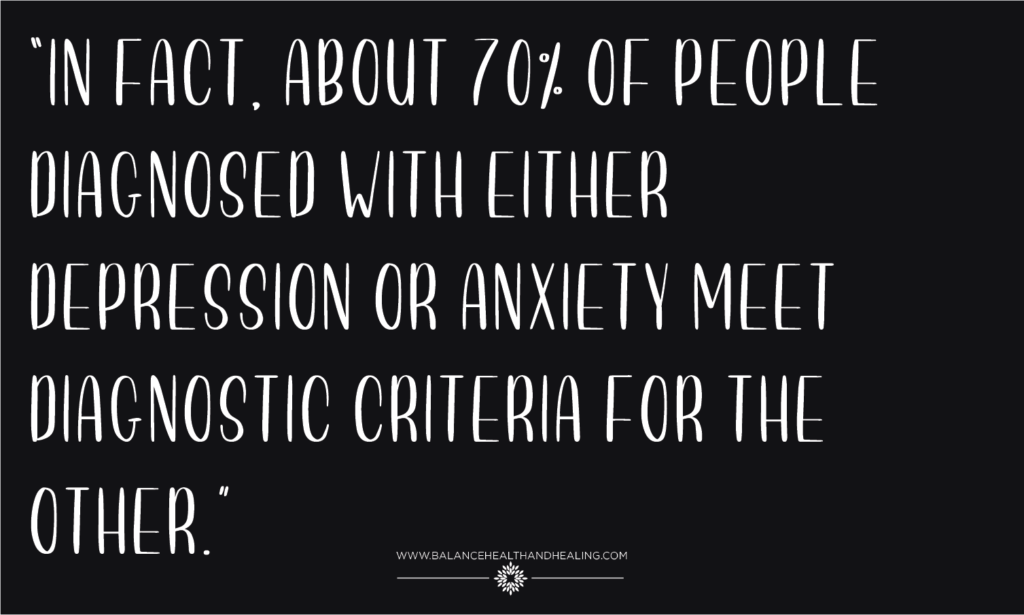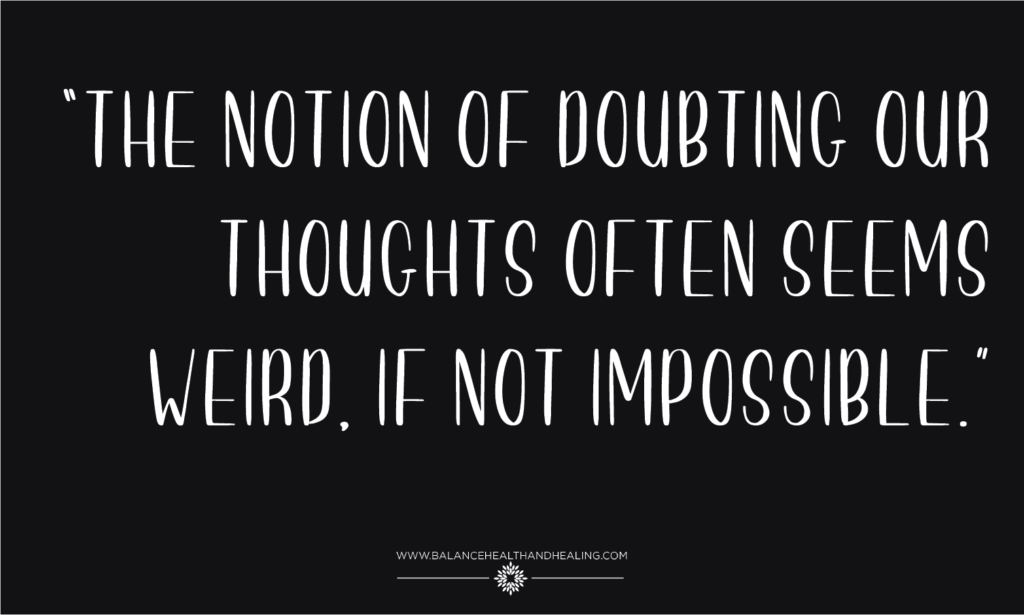Sometimes I share with clients that depression and anxiety function like con artists. They take some data, usually recent memories or expectations, and weave a story that fits their picture best. They get us to buy in, to give them power and sway, often against our better judgment. To make matters worse, they often work together. A  depressive thought like “you’re such a failure” naturally leads to more anxious thoughts like “and now you’re going to fail again, and it’s going to be terrible” and then back to a depressive thought like “and things always will be terrible.” In fact, about 70% of people diagnosed with either depression or anxiety meet diagnostic criteria for the other. Depression and anxiety might be, in many respects, two sides of the same coin. For our purposes, we can consider them two illusion-creators who work in tandem to strengthen their illusions.
depressive thought like “you’re such a failure” naturally leads to more anxious thoughts like “and now you’re going to fail again, and it’s going to be terrible” and then back to a depressive thought like “and things always will be terrible.” In fact, about 70% of people diagnosed with either depression or anxiety meet diagnostic criteria for the other. Depression and anxiety might be, in many respects, two sides of the same coin. For our purposes, we can consider them two illusion-creators who work in tandem to strengthen their illusions.
As a therapist, it can be heartbreaking to talk with someone whose self-concept has succumbed to the con artists. I’ve met with many talented people convinced they had nothing to offer the world, with many bright students crippled by the thought that they will fail to hit some standard of excellence, and with many beautiful souls who, in introspection, could only see their foibles and blemishes.
Part of the therapeutic process in these cases involves helping people see themselves as complex beings, who sometimes miss and sometimes hit their mark, and that this is true for everyone. As Stephen McCraine said, “The master has failed more times than the beginner has even tried.” However, the parts of our minds that perpetuate depressive moods try to convince us that failing means we are failures and will always be failures. The differences between the person struggling with depression and the person not struggling with it lie ultimately not in performance and worth but in beliefs and expectations about performance and worth. When we buy into these beliefs and expectations, they become self-fulfilling.
Anxiety and depression use another trick as con artists: they disguise themselves as ourselves. That is, when our thoughts go to those dark places, when they paint a bleak and hopeless future, it feels not only very convincing but also as if we ourselves are doing the convincing. It’s challenging to doubt what appears to come from our hearts of hearts. If someone with all your features, but somewhat older-looking, apparated in your house and warned you not to go to such-and-such a city on such-and-such a date, you’d likely–after verifying you’re not dreaming–trust them. Of course you would. They would bear every resemblance to you.
With our thoughts, the situation is similar. Our default mode is to trust what our minds say about ourselves and about the world. The notion of doubting our thoughts often  seems weird, if not impossible. But psychologists have devised and discovered ways to do this effectively, to forge some distance between our observing selves and our thoughts. Let’s try an exercise to demonstrate this idea. Right now, close your eyes for 10 seconds and watch the thoughts that come into and out of your mind. Watch what your mind does . . .
seems weird, if not impossible. But psychologists have devised and discovered ways to do this effectively, to forge some distance between our observing selves and our thoughts. Let’s try an exercise to demonstrate this idea. Right now, close your eyes for 10 seconds and watch the thoughts that come into and out of your mind. Watch what your mind does . . .
What did you notice? What sorts of things did it say or do? Many people notice thoughts about something they plan to do later that day, some conversations they had in the past, or a host of other things. Also notice how the thoughts seemed to form. Where were they coming from? If you could spatially locate them, where would upi point? The goal of this sort of exercise is to show an elusive truth–that we are not our thoughts, that we are often not even their primary authors. This brings up questions about what constitutes the self, which is a whole other philosophical can of worms. Suffice it to say that, from this perspective, we identify the self as that part of you that notices your experience. So when you’re watching your thoughts, notice them, but also notice that you’re noticing.
This skillset is important to many ends, not just managing anxiety and depression. But within this example, it helps draw observational distance between you and the depressive and anxious parts of your mind. This, in turn, allows you to decide what to do about those thoughts, rather than feeling steered and controlled by them. It imbues you with the ability to see depressive and anxious thoughts for the (frequent) liars and exaggerators they are. Almost none of the things we worry about will happen. Almost none of the extreme negative judgments we make about ourselves, our lives, or other people are true. But it is very hard to see that when we are still entangled with our thoughts.
 One issue with the con artist comparison is that it fails to account for the elements of sadness and anxiousness that are actually helpful. I first heard depression and anxiety compared to con artists by David Burns, a cognitive psychologist. Usually the goal for cognitive psychologists is to diminish or eliminate depression and anxiety by making our thoughts more rational and reality-based. And this approach works for many people. Still, some find it more helpful to focus on changing their relationship to these thoughts and feelings. After all, it’s tough to control what thoughts come into our minds and what thoughts don’t.
One issue with the con artist comparison is that it fails to account for the elements of sadness and anxiousness that are actually helpful. I first heard depression and anxiety compared to con artists by David Burns, a cognitive psychologist. Usually the goal for cognitive psychologists is to diminish or eliminate depression and anxiety by making our thoughts more rational and reality-based. And this approach works for many people. Still, some find it more helpful to focus on changing their relationship to these thoughts and feelings. After all, it’s tough to control what thoughts come into our minds and what thoughts don’t.
The film Inside Out argued that sadness and fear serve useful functions, as long as they don’t assume full control. Feeling sad when we’ve lost someone emphasizes the importance of that bond. It helps us learn what we value and why. Feeling anxious when we’re standing near a cliff helps us avoid fruitless danger. As Uncle Iroh said, “It is important to draw wisdom from many different places. If we draw it from one place, it becomes rigid and stale.” Remembering that sadness and fear are often liars is immensely helpful, and it’s also helpful to remember that they sometimes speak the truth. Learning to tell the difference between these times is one sure mark of wisdom.

